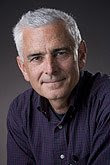 Craig Hogan, head of the Center for Particle Astrophysics, wrote this week’s column.
Craig Hogan, head of the Center for Particle Astrophysics, wrote this week’s column.“Inner space, outer space” is Fermilab’s term for the observation that everything in the universe is connected to everything else. Experiments have found that even the biggest and smallest things in the universe depend on each other in surprising, profound and sometimes subtle ways.
Fermilab’s Tevatron, the best operating microscope in the world, allows us to study inner space. The Dark Energy Survey, for which Fermilab is building a giant camera, will map quantum effects on the largest cosmic scales of outer space. Now interferometers, a new kind of instrument to detect gravitational waves, promise to scrutinize inner space and outer space at the same time in the same apparatus. They’ll possibly allow a glimpse of a new kind of big-small interconnectedness: quantum space.
Interferometers such as the Laser Interferometer Gravitational Wave Observatory in the U.S. and the GEO600 project in Germany use laser cavities to create a coherent quantum state that spans several kilometers. They look with extraordinary precision for tiny distortions of space--even smaller than the distances accessible by the Tevatron. Their precision is like measuring the position of Mars to within the diameter of an atom.
Interferometers were built to study gravitational radiation. But recently we realized they could also discover new physics they were not designed to detect--including phenomena at the Planck scale, the smallest fundamental interval of space and time.
Black hole physics and string theory suggest that quantum spacetime might be holographic: Our familiar three dimensions of space might be the result of a quantum theory that only has two large spatial dimensions. The third dimension emerges as time evolves: picture a two-dimensional sheet sweeping through space at the speed of light.
Such a holographic universe would have a kind of quantum blurriness in its geometry that would appear in interferometers as "holographic noise.” There are hints that this excess noise might already appear in data recorded by interferometers. We may soon have the first direct evidence for the quantum geometry of our universe and obtain a precise determination of the smallest fundamental interval of time. If so, this measurement could revolutionize our understanding of the universe, similar to the measurement of “noise” that led to the discovery of the cosmic microwave background in 1965.
Excerpted: Fermilab Today
